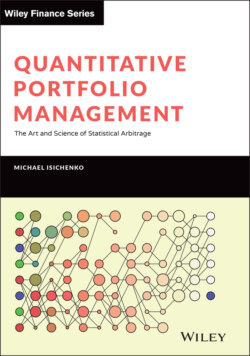Quantitative Portfolio Management

Реклама. ООО «ЛитРес», ИНН: 7719571260.
Оглавление
Michael Isichenko. Quantitative Portfolio Management
Table of Contents
Guide
Pages
Quantitative Portfolio Management. The art and science of statistical arbitrage
List of Figures
Code Listings
Preface
About this Book
Abstract
Acknowledgments
Introduction
Chapter 1 Market Data
1.1 Tick and bar data
1.2 Corporate actions and adjustment factor
1.3 Linear vs log returns
Chapter 2 Forecasting
2.1 Data for forecasts
2.1.1 Point-in-time and lookahead
2.1.2 Security master and survival bias
2.1.3 Fundamental and accounting data
2.1.4 Analyst estimates
2.1.5 Supply chain and competition
2.1.6 M&A and risk arbitrage
2.1.7 Event-based predictors
2.1.8 Holdings and flows
2.1.9 News and social media
2.1.10 Macroeconomic data
2.1.11 Alternative data
2.1.12 Alpha capture
2.2 Technical forecasts
2.2.1 Mean reversion
2.2.2 Momentum
2.2.3 Trading volume
2.2.4 Statistical predictors
2.2.5 Data from other asset classes
2.3 Basic concepts of statistical learning
2.3.1 Mutual information and Shannon entropy
2.3.2 Likelihood and Bayesian inference
2.3.3 Mean square error and correlation
2.3.4 Weighted law of large numbers
2.3.5 Bias-variance tradeoff
Listing 2.1 Bias-variance tradeoff for 100 OLS features. The output is in Fig. 2.3
2.3.6 PAC learnability, VC dimension, and generalization error bounds
2.4 Machine learning
2.4.1 Types of machine learning
2.4.2 Overfitting
2.4.3 Ordinary and generalized least squares
2.4.4 Deep learning
2.4.5 Types of neural networks
2.4.6 Nonparametric methods
2.4.7 Hyperparameters
2.4.8 Cross-validation
2.4.9 Convex regression
2.4.10 Curse of dimensionality, eigenvalue cleaning, and shrinkage
Listing 2.2 Generation of empirical and Marchenko-Pastur distributions of the eigenvalues of a pure-noise covariance matrix. The result is in Fig. 2.7
2.4.11 Smoothing and regularization
Listing 2.3 Local Linear Regression (LLR) solver based on Eqs. (2.74)-(2.75). The code is used for Fig. 2.9
Listing 2.4 GP regression over noisy data. The result is in Fig. 2.10
Listing 2.5 Lasso regression with varying penalty. The result is in Fig. 2.12
2.4.12 Generalization puzzle of deep and overparameterized learning
Listing 2.6 Double dip of generalization error. The result is in Fig. 2.13
2.4.13 Online machine learning
2.4.14 Boosting
2.4.15 Twicing
2.4.16 Randomized learning
2.4.17 Latent structure
2.4.18 No free lunch and AutoML
2.4.19 Computer power and machine learning
2.5 Dynamical modeling
2.6 Alternative reality
2.7 Timeliness-significance tradeoff
2.8 Grouping
2.9 Conditioning
2.10 Pairwise predictors
2.11 Forecast for securities from their linear combinations
2.12 Forecast research vs simulation
Chapter 3 Forecast Combining
3.1 Correlation and diversification
3.2 Portfolio combining
3.3 Mean-variance combination of forecasts
3.4 Combining features vs combining forecasts
3.5 Dimensionality reduction
3.5.1 PCA, PCR, CCA, ICA, LCA, and PLS
3.5.2 Clustering
3.5.3 Hierarchical combining
3.6 Synthetic security view
3.7 Collaborative filtering
3.8 Alpha pool management
3.8.1 Forecast development guidelines
3.8.2 Pnl attribution
Chapter 4 Risk
4.1 Value at risk and expected shortfall
4.2 Factor models
4.3 Types of risk factors
4.4 Return and risk decomposition
4.5 Weighted PCA
4.6 PCA transformation
4.7 Crowding and liquidation
4.8 Liquidity risk and short squeeze
4.9 Forecast uncertainty and alpha risk
Chapter 5 Trading Costs and Market Elasticity
5.1 Slippage
5.2 Impact
5.2.1 Empirical observations
5.2.2 Linear impact model
5.2.3 Instantaneous impact cost model
5.2.4 Impact arbitrage
5.3 Cost of carry
5.4 Market-wide impact and elasticity
Chapter 6 Portfolio Construction
6.1 Hedged allocation
6.2 Forecast from rule-based strategy
6.3 Single-period vs multi-period mean-variance utility
6.4 Single-name multi-period optimization
6.4.1 Optimization with fast impact decay
6.4.2 Optimization with exponentially decaying impact
6.4.3 Optimization conditional on a future position
6.4.4 Position value and utility leak
6.4.5 Optimization with slippage
6.5 Multi-period portfolio optimization
6.5.1 Unconstrained portfolio optimization with linear impact costs
6.5.2 Iterative handling of factor risk
6.5.3 Optimizing future EMA positions
6.5.4 Portfolio optimization using utility leak rate
6.5.5 Notes on portfolio optimization with slippage
6.6 Portfolio capacity
6.7 Portfolio optimization with forecast revision
6.8 Portfolio optimization with forecast uncertainty
6.9 Kelly criterion and optimal leverage
6.10 Intraday optimization and execution
6.10.1 Trade curve
6.10.2 Forecast-timed execution
6.10.3 Algorithmic trading and HFT
6.10.4 HFT controversy
Chapter 7 Simulation
7.1 Simulation vs production
7.2 Simulation and overfitting
7.3 Research and simulation efficiency
7.4 Paper trading
7.5 Bugs
Listing 7.1 Examples of helpful C++ macros
Listing 7.2 Bilingual C++/Python file generating repetitive C++ code
Afterword: Economic and Social Aspects of Quant Trading
Appendix
A1 Secmaster mappings
A2 Woodbury matrix identities
A3 Toeplitz matrix
Index
Question Index
Quotes Index
Stories Index
WILEY END USER LICENSE AGREEMENT
Отрывок из книги
Michael Isichenko
The quant trading business, especially its alpha part, tends to be fairly secretive, but the traffic of portfolio managers and analysts between quant shops has created a body of common knowledge, some of which has been published in the literature. The book is an attempt to cover parts of this knowledge, as well as to add a few ideas developed by the author in his own free time. I appreciate the concern of some of the more advanced colleagues of mine about letting the tricks of the trade “out in the wild.” Those tricks, such as machine learning and optimization algorithms, are mostly in the public domain already but are spread over multiple fields. In addition to academic research, Wall Street can learn a lot from Silicon Valley, whose inhabitants have generated a tremendous and less secretive body of knowledge. Using an analogy with cryptography, sec urity through obscurity is a popular approach in quantitative trading, but it gradually gives way to security by design ultimately rooted in the increasingly difficult forecasting of future asset prices, the holy skill and grail of quantitative portfolio management. The rest of the quant trading process, while not exactly trivial in scope, is within the reach of a reasonably trained scientist, this author included, who is willing and able to read Wikipedia,1 and learn better coding.
.....
and formula (1.3) follows.3
Some quant shops have used a similar reinvestment logic of buying shares of stock at the new closing price resulting in a somewhat simpler day adjustment factor,
.....